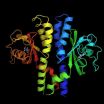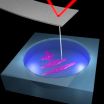(Press-News.org) EUGENE, Ore. -- (June 14, 2012) -- University of Oregon scientists have discovered how the bacterium Helicobacter pylori navigates through the acidic stomach, opening up new possibilities to inactivate its disease-causing ability without using current strategies that often fail or are discontinued because of side effects.
Their report -- online ahead of regular publication July 3 in the journal Structure -- unveils the crystal structure of H. pylori's acid receptor TlpB. The receptor has an external protrusion, identified as a PAS domain, bound by a small molecule called urea and is poised to sense the external environment. TlpB is the first bacterial chemoreceptor of known function shown by crystallography to contain an extracellular PAS domain, the researchers reported.
"It is a beautiful structure, and this domain has never been seen before in this class of proteins," said co-author S. James Remington, professor of physics and member of the UO Institute of Molecular Biology. Captured at the atomic resolution of 1.38 angstroms, it is the first new, significant structural view in 20 years of the class of receptors used by bacteria to navigate their chemical environment.
H. pylori, a Gram-negative bacterium, was first identified in 1982 and shown to be associated with stomach ulcers and stomach cancer. While its mode of transmission is not precisely understood, the bacterium is found in the stomach of half of the people in the world, said co-author Karen Guillemin, professor of biology and also a member of the Institute of Molecular Biology. To fight H. pylori infections, patients generally are treated with broad-spectrum antibiotics, but the bacterium is becoming resistant and treatment fails in about 30 percent of cases.
As part of the new UO study -- led by postdoctoral researcher Emily G. Sweeney and doctoral student J. Nathan Henderson, now a postdoctoral researcher at Arizona State University -- researchers manipulated the atomic structure of the protein to disrupt its ability to bind urea, and demonstrated that the urea is the key to how the bacterium senses and avoids acid.
When the receptor is unable to bind urea, Guillemin said, the bacteria became confused and were unable to navigate away from high acid. "We found that this urea binding is absolutely crucial for this protein to act as an acid sensor," she said.
"We now have significant new insights into how acid sensing works at the atomic level which is important for H. pylori's life in the stomach" Guillemin said. "The health implications are this: If we disrupt the binding of urea, we can confuse the bacteria and potentially block their ability to reach the stomach lining where they cause damage."
The new research so far only presents "snapshots along the way" of the H. pylori's signaling process, Remington said. More study is needed to understand the mechanisms involved, but the new structure now lets researchers see the some 3,000 individual atoms -- and where they are located -- in the newly discovered urea-binding protein domain.
"This interdisciplinary research team worked together to approach a problem and provide fundamental new knowledge about this bacterium's basic structure," said Kimberly Andrews Espy, vice president for research and innovation at the UO. "As a result, we are able to understand the discovery in the context of disease and how human health might benefit."
INFORMATION:
Five other co-authors were on the paper with Guillemin, Remington, Sweeney and Henderson. They were: John Goers, professor of biochemistry at California Polytechnic State University; Chris Wreden, research assistant in the UO Institute of Molecular Biology (IMB); Kevin G. Hicks, an undergraduate student in the UO IMB who now is a doctoral student in microbiology at the University of Washington in Seattle; UO graduate student Jeneva K. Foster of the UO IMB; and UO physicist Raghuveer Parthasarathy of the UO IMB and Materials Science Institute.
The National Institutes of Health supported the research through grants to Guillemin (DK075667-04) and to Sweeney (AI091098-02). Remington was supported by the National Science Foundation (grant MCB-1021374).
About the University of Oregon
The University of Oregon is among the 108 institutions chosen from 4,633 U.S. universities for top-tier designation of "Very High Research Activity" in the 2010 Carnegie Classification of Institutions of Higher Education. The UO also is one of two Pacific Northwest members of the Association of American Universities.
Sources: Karen Guillemin, associate professor of biology, 541-346-5360, kguillem@uoregon.edu, and S. James Remington, professor of physics, 541-346-5190, jreming@uoregon.edu
Links:
Guillemin faculty page: http://molbio.uoregon.edu/facres/guillemin.html
Remington faculty page: http://molbio.uoregon.edu/facres/remington.html
Department of Biology: http://biology.uoregon.edu/
Institute of Molecular Biology: http://molbio.uoregon.edu/
Department of Physics: http://physics.uoregon.edu/
Follow UO Science on Facebook: http://www.facebook.com/UniversityOfOregonScience
Note: The University of Oregon is equipped with an on-campus television studio with satellite uplink capacity, and a radio studio with an ISDN phone line for broadcast-quality radio interviews. Call the Media Contact above to begin the process.
Atomic-resolution view of a receptor reveals how stomach bacterium avoids acid
2012-06-15
ELSE PRESS RELEASES FROM THIS DATE:
Elderly prisoners need better medical care, according to report
2012-06-15
Soaring numbers of older, sicker prisoners are causing an unprecedented health care challenge for the nation's criminal justice system, according to a new UCSF report.
As the American penal system confronts a costly demographic shift toward older prisoners, the authors call for an overhaul in health care practices for elderly inmates who disproportionately account for escalating medical expenses behind bars. The recommendations include screening for dementia among prisoners, improved palliative care, and standard policies for geriatric housing units for infirm inmates.
The ...
Stanford engineers perfecting carbon nanotubes for highly energy-efficient computing
2012-06-15
Energy efficiency is the most significant challenge standing in the way of continued miniaturization of electronic systems, and miniaturization is the principal driver of the semiconductor industry. "As we approach the ultimate limits of Moore's Law, however, silicon will have to be replaced in order to miniaturize further," said Jeffrey Bokor, deputy director for science at the Molecular Foundry at the Lawrence Berkeley National Laboratory and Professor at UC-Berkeley.
To this end, carbon nanotubes (CNTs) are a significant departure from traditional silicon technologies ...
Tense film scenes trigger brain activity, CCNY-led team finds
2012-06-15
Visual and auditory stimuli that elicit high levels of engagement and emotional response can be linked to reliable patterns of brain activity, a team of researchers from The City College of New York and Columbia University reports. Their findings could lead to new ways for producers of films, television programs and commercials to predict what kinds of scenes their audiences will respond to.
"Peak correlations of neural activity across viewings can occur in remarkable correspondence with arousing moments of the film," the researchers said in an article published in the ...
Environmental factors spread obesity, CCNY-led team reports
2012-06-15
An international team of researchers' study of the spatial patterns of the spread of obesity suggests America's bulging waistlines may have more to do with collective behavior than genetics or individual choices. The team, led by City College of New York physicist Hernán Makse, found correlations between the epidemic's geography and food marketing and distribution patterns.
"We found there is a relationship between the prevalence of obesity and the growth of the supermarket economy," Professor Makse said. "While we can't claim causality because we don't know whether obesity ...
Gone fishing: Researchers' imaging technique trolls in quiet cellular seas
2012-06-15
CHAMPAIGN, Ill. — Experienced anglers know that choppy waters make for difficult fishing, so they try not to rock the boat. Thanks to a new microscopy technique, cell biology researchers can heed that same advice.
University of Illinois researchers developed a method they call "trolling AFM," which allows them to study soft biological samples in liquid with high resolution and high quality. Led by mechanical science and engineering professor Min-Feng Yu, the group published its findings in the journal Nanotechnology.
"We developed a highly sensitive method for high-resolution ...
Take-home methadone maintenance treatment associated with decreased hospital admissions
2012-06-15
(Boston) – A recent study conducted by researchers at Boston Medical Center (BMC) shows that patients receiving "take home" methadone maintenance treatment (MMT) were less likely to be admitted to the hospital as compared to those not receiving take home doses. The findings, which are published online in the Journal of Addiction Medicine, demonstrate the potential benefits of successful addiction treatment, including better overall health and decreased health care utilization.
This research was led by Alexander Walley, MD, MSc, physician in general internal medicine at ...
9 out of 10 non-elderly Californians will be covered under Affordable Care Act
2012-06-15
Nine out of 10 Californians under the age of 65 will be enrolled in health insurance programs as a result of the Patient Protection and Affordable Care Act (ACA), according to a joint study by the UC Berkeley Center for Labor Research and Education and the UCLA Center for Health Policy Research.
Between 1.8 million and 2.7 million previously uninsured Californians will gain coverage by 2019, when the law's effect is fully realized, the researchers said.
The report, which uses a sophisticated computer simulation model to project the ACA's impact on insurance coverage, ...
How aging normal cells fuel tumor growth and metastasis
2012-06-15
PHILADELPHIA—It has long been known that cancer is a disease of aging, but a molecular link between the two has remained elusive.
Now, researchers at the Kimmel Cancer Center at Jefferson (KCC) have shown that senescence (aging cells which lose their ability to divide) and autophagy (self-eating or self-cannibalism) in the surrounding normal cells of a tumor are essentially two sides of the same coin, acting as "food" to fuel cancer cell growth and metastasis.
Michael P. Lisanti, M.D., Ph.D., Professor and Chair of Stem Cell Biology and Regenerative Medicine at Jefferson ...
Soft drink consumption not the major contributor to childhood obesity
2012-06-15
Ottawa, Ontario (June 14, 2012) – Most children and youth who consume soft drinks and other sweetened beverages, such as fruit punch and lemonade, are not at any higher risk for obesity than their peers who drink healthy beverages, says a new study published in the October issue of Applied Physiology, Nutrition, and Metabolism. The study examined the relationship between beverage intake patterns of Canadian children and their risk for obesity and found sweetened beverage intake to be a risk factor only in boys aged 6-11.
"We found sweetened drinks to be dominant beverages ...
Study finds predators have outsized influence over habitats
2012-06-15
A grasshopper's change in diet to high-energy carbohydrates while being hunted by spiders may affect the way soil releases carbon dioxide into the atmosphere, according to Yale and Hebrew University researchers in Science.
Grasshoppers like to munch on nitrogen-rich grass because it stimulates their growth and reproduction. But when spiders enter the picture, grasshoppers cope with the stress from fear of predation by shifting to carbohydrate-rich plants, setting in motion dynamic changes to the ecosystem they inhabit.
"Under stressful conditions they go to different ...



